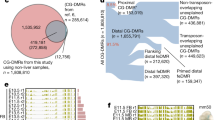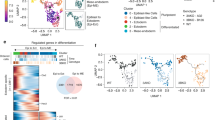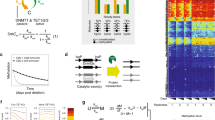Abstract
Methylation of cytosines is an essential epigenetic modification in mammalian genomes, yet the rules that govern methylation patterns remain largely elusive. To gain insights into this process, we generated base-pair-resolution mouse methylomes in stem cells and neuronal progenitors. Advanced quantitative analysis identified low-methylated regions (LMRs) with an average methylation of 30%. These represent CpG-poor distal regulatory regions as evidenced by location, DNase I hypersensitivity, presence of enhancer chromatin marks and enhancer activity in reporter assays. LMRs are occupied by DNA-binding factors and their binding is necessary and sufficient to create LMRs. A comparison of neuronal and stem-cell methylomes confirms this dependency, as cell-type-specific LMRs are occupied by cell-type-specific transcription factors. This study provides methylome references for the mouse and shows that DNA-binding factors locally influence DNA methylation, enabling the identification of active regulatory regions.
This is a preview of subscription content, access via your institution
Access options
Subscribe to this journal
Receive 51 print issues and online access
$199.00 per year
only $3.90 per issue
Buy this article
- Purchase on SpringerLink
- Instant access to full article PDF
Prices may be subject to local taxes which are calculated during checkout





Similar content being viewed by others
Change history
25 April 2012
Nature 480, 490–495 (2011) In the original version of this Article Erik van Nimwegen (Biozentrum of the University of Basel and Swiss Institute of Bioinformatics, Klingelbergstrasse 50-70, CH 4056 Basel, Switzerland) was inadvertently omitted from the author list. In the ‘Author contribution’ section the sentence beginning “Bioinformatic and statistical analyses.
References
Bird, A. DNA methylation patterns and epigenetic memory. Genes Dev. 16, 6–21 (2002)
Reik, W. Stability and flexibility of epigenetic gene regulation in mammalian development. Nature 447, 425–432 (2007)
Lister, R. et al. Human DNA methylomes at base resolution show widespread epigenomic differences. Nature 462, 315–322 (2009)
Meissner, A. et al. Genome-scale DNA methylation maps of pluripotent and differentiated cells. Nature 454, 766–770 (2008)
Bibel, M., Richter, J., Lacroix, E. & Barde, Y. A. Generation of a defined and uniform population of CNS progenitors and neurons from mouse embryonic stem cells. Nature Protocols 2, 1034–1043 (2007)
Lienert, F. et al. Genomic prevalence of heterochromatic H3K9me2 and transcription do not discriminate pluripotent from terminally differentiated cells. PLoS Genet. 7, e1002090 (2011)
Mohn, F. et al. Lineage-specific polycomb targets and de novo DNA methylation define restriction and potential of neuronal progenitors. Mol. Cell 30, 755–766 (2008)
Keane, T. M. et al. Mouse genomic variation and its effect on phenotypes and gene regulation. Nature 477, 289–294 (2011)
Borgel, J. et al. Targets and dynamics of promoter DNA methylation during early mouse development. Nature Genet. 42, 1093–1100 (2010)
Birney, E. et al. Identification and analysis of functional elements in 1% of the human genome by the ENCODE pilot project. Nature 447, 799–816 (2007)
Gross, D. S. & Garrard, W. T. Nuclease hypersensitive sites in chromatin. Annu. Rev. Biochem. 57, 159–197 (1988)
Sabo, P. J. et al. Genome-wide identification of DNaseI hypersensitive sites using active chromatin sequence libraries. Proc. Natl Acad. Sci. USA 101, 4537–4542 (2004)
Heintzman, N. D. et al. Distinct and predictive chromatin signatures of transcriptional promoters and enhancers in the human genome. Nature Genet. 39, 311–318 (2007)
Rada-Iglesias, A. et al. A unique chromatin signature uncovers early developmental enhancers in humans. Nature 470, 279–283 (2011)
Ohlsson, R., Bartkuhn, M. & Renkawitz, R. CTCF shapes chromatin by multiple mechanisms: the impact of 20 years of CTCF research on understanding the workings of chromatin. Chromosoma 119, 351–360 (2010)
Kagey, M. H. et al. Mediator and cohesin connect gene expression and chromatin architecture. Nature 467, 430–435 (2010)
Pastor, W. A. et al. Genome-wide mapping of 5-hydroxymethylcytosine in embryonic stem cells. Nature 473, 394–397 (2011)
Stroud, H., Feng, S., Morey Kinney, S., Pradhan, S. & Jacobsen, S. E. 5-Hydroxymethylcytosine is associated with enhancers and gene bodies in human embryonic stem cells. Genome Biol. 12, R54 (2011)
Szulwach, K. E. et al. Integrating 5-hydroxymethylcytosine into the epigenomic landscape of human embryonic stem cells. PLoS Genet. 7, e1002154 (2011)
Williams, K. et al. TET1 and hydroxymethylcytosine in transcription and DNA methylation fidelity. Nature 473, 343–348 (2011)
Wu, H. et al. Dual functions of Tet1 in transcriptional regulation in mouse embryonic stem cells. Nature 473, 389–393 (2011)
Kim, T. H. et al. Analysis of the vertebrate insulator protein CTCF-binding sites in the human genome. Cell 128, 1231–1245 (2007)
Wendt, K. S. et al. Cohesin mediates transcriptional insulation by CCCTC-binding factor. Nature 451, 796–801 (2008)
Cohen, N. M. et al. DNA methylation programming and reprogramming in primate embryonic stem cells. Genome Res. 19, 2193–2201 (2009)
Lienert, F. et al. Identification of genetic elements that autonomously determine DNA methylation states. Nature Genet. 43, 1091–1097 (2011)
Tsumura, A. et al. Maintenance of self-renewal ability of mouse embryonic stem cells in the absence of DNA methyltransferases Dnmt1, Dnmt3a and Dnmt3b. Genes Cells 11, 805–814 (2006)
Bell, A. C. & Felsenfeld, G. Methylation of a CTCF-dependent boundary controls imprinted expression of the Igf2 gene. Nature 405, 482–485 (2000)
Hark, A. T. et al. CTCF mediates methylation-sensitive enhancer-blocking activity at the H19/Igf2 locus. Nature 405, 486–489 (2000)
Jorgensen, H. F., Chen, Z. F., Merkenschlager, M. & Fisher, A. G. Is REST required for ESC pluripotency? Nature 457, E4–E5 (2009)
Splinter, E. et al. CTCF mediates long-range chromatin looping and local histone modification in the β-globin locus. Genes Dev. 20, 2349–2354 (2006)
Bibel, M. et al. Differentiation of mouse embryonic stem cells into a defined neuronal lineage. Nature Neurosci. 7, 1003–1009 (2004)
Takahashi, K. & Yamanaka, S. Induction of pluripotent stem cells from mouse embryonic and adult fibroblast cultures by defined factors. Cell 126, 663–676 (2006)
Kinoshita, K. et al. GABPα regulates Oct-3/4 expression in mouse embryonic stem cells. Biochem. Biophys. Res. Commun. 353, 686–691 (2007)
Sohn, J. et al. Identification of Sox17 as a transcription factor that regulates oligodendrocyte development. J. Neurosci. 26, 9722–9735 (2006)
Chen, X. et al. Integration of external signaling pathways with the core transcriptional network in embryonic stem cells. Cell 133, 1106–1117 (2008)
Bryne, J. C. et al. JASPAR, the open access database of transcription factor-binding profiles: new content and tools in the 2008 update. Nucleic Acids Res. 36, D102–D106 (2008)
Illingworth, R. S. & Bird, A. P. CpG islands – ‘a rough guide’. FEBS Lett. 583, 1713–1720 (2009)
Hodges, E. et al. Directional DNA methylation changes and complex intermediate states accompany lineage specificity in the adult hematopoietic compartment. Mol. Cell 44, 17–28 (2011)
Irizarry, R. A. et al. The human colon cancer methylome shows similar hypo- and hypermethylation at conserved tissue-specific CpG island shores. Nature Genet. 41, 178–186 (2009)
Brunk, B. P., Goldhamer, D. J. & Emerson, C. P., Jr Regulated demethylation of the myoD distal enhancer during skeletal myogenesis. Dev. Biol. 177, 490–503 (1996)
Mareš, J. et al. Methylation changes in promoter and enhancer regions of the WT1 gene in Wilms’ tumours. Cancer Lett. 166, 165–171 (2001)
Sharrard, R. M., Royds, J. A., Rogers, S. & Shorthouse, A. J. Patterns of methylation of the c-myc gene in human colorectal cancer progression. Br. J. Cancer 65, 667–672 (1992)
Tagoh, H. et al. Dynamic reorganization of chromatin structure and selective DNA demethylation prior to stable enhancer complex formation during differentiation of primary hematopoietic cells in vitro. Blood 103, 2950–2955 (2004)
Thomassin, H., Flavin, M., Espinas, M. L. & Grange, T. Glucocorticoid-induced DNA demethylation and gene memory during development. EMBO J. 20, 1974–1983 (2001)
Groudine, M. & Conkin, K. F. Chromatin structure and de novo methylation of sperm DNA: implications for activation of the paternal genome Science. 228, 1061–1068 (1985)
Colaneri, A. et al. Expanded methyl-sensitive cut counting reveals hypomethylation as an epigenetic state that highlights functional sequences of the genome. Proc. Natl Acad. Sci. USA 108, 9715–9720 (2011)
Boyle, A. P. & Furey, T. S. High-resolution mapping studies of chromatin and gene regulatory elements. Epigenomics 1, 319–329 (2009)
Abbott, A. Europe to map the human epigenome. Nature 477, 518 (2011)
Satterlee, J. S., Schubeler, D. & Ng, H. H. Tackling the epigenome: challenges and opportunities for collaboration. Nature Biotechnol. 28, 1039–1044 (2010)
Langmead, B., Trapnell, C., Pop, M. & Salzberg, S. L. Ultrafast and memory-efficient alignment of short DNA sequences to the human genome. Genome Biol. 10, R25 (2009)
Acknowledgements
The authors thank A. Fernandez, C. Kohler, V. Petitjean and F. Staedtler (Novartis) and I. Nissen and C. Beisel (ETH-BSSE) for performing next generation sequencing experiments. R. Lister and J. Ecker for technical advice on BisSeq library generation. D. Schmitz for the pcDNA6-IRES-Blasticidin vector. D. Anderson for the REST antibody. H. Jørgensen for REST cds. L. Hoerner for help in Sanger bisulphite sequencing. M. Lorincz, N. Thomä and members of the Schübeler laboratory for feedback on the manuscript. R.M. is supported by an EMBO long-term postdoctoral fellowship. V.K.T. is supported by a Marie Curie International Incoming fellowship and an EMBO long-term postdoctoral fellowship. Research in the laboratory of D.S. is supported by the Novartis Research Foundation, the European Union (NoE “EpiGeneSys” FP7-HEALTH-2010-257082), the European Research Council (ERC EpiGePlas), the SNF Sinergia program and the Swiss initiative in Systems Biology (Cell Plasticity).
Author information
Authors and Affiliations
Contributions
Experiments were designed by R.M., F.L., A.S., V.K.T., E.J.O. and D.S. BisSeq, RNA-Seq and ChIP-seq experiments were conducted by R.M., A.S. and V.K.T. ChIP-seq data analysis was performed by M.B.S. and L.B. BS-PCR validation was performed by R.M., F.L. and C.W. Sequencing data processing was performed by D.G. and M.B.S. LMRs were first noticed by D.G. Bioinformatic and statistical analyses were conducted by M.B.S., L.B., R.I. and E.v.N. The manuscript was prepared by R.M., M.B.S., L.B. and D.S.
Corresponding author
Ethics declarations
Competing interests
The authors declare no competing financial interests.
Supplementary information
Supplementary Information
The file contains Supplementary Figures 1-16 with legends, Supplementary Methods and additional references. The methods in this file were replaced on 25 April 2012. (PDF 16260 kb)
Supplementary Table 1
The table displays details of sequence datasets used in this study, and additional references (for external data sets only). (DOC 56 kb)
Supplementary Table 2
The table displays methylation segments identified in ES cells. (CSV 9880 kb)
Supplementary Table 3
The table displays Methylation segments identified in NP. A short description of each column is given at the top of the table. (CSV 7235 kb)
Supplementary Table 4
The table displays Genotype structure of the ES cell line used in the study. (CSV 29 kb)
Rights and permissions
About this article
Cite this article
Stadler, M., Murr, R., Burger, L. et al. DNA-binding factors shape the mouse methylome at distal regulatory regions. Nature 480, 490–495 (2011). https://doi.org/10.1038/nature10716
Received:
Accepted:
Published:
Issue Date:
DOI: https://doi.org/10.1038/nature10716
This article is cited by
-
Characterisation and reproducibility of the HumanMethylationEPIC v2.0 BeadChip for DNA methylation profiling
BMC Genomics (2024)
-
Profiling the immune epigenome across global cattle breeds
Genome Biology (2023)
-
High temperature influences DNA methylation and transcriptional profiles in sea urchins (Strongylocentrotus intermedius)
BMC Genomics (2023)
-
Genic constraint against nonsynonymous variation across the mouse genome
BMC Genomics (2023)
-
DNA methylation alterations at RE1-silencing transcription factor binding sites and their flanking regions in cancer
Clinical Epigenetics (2023)



